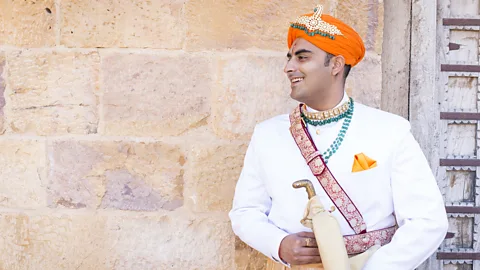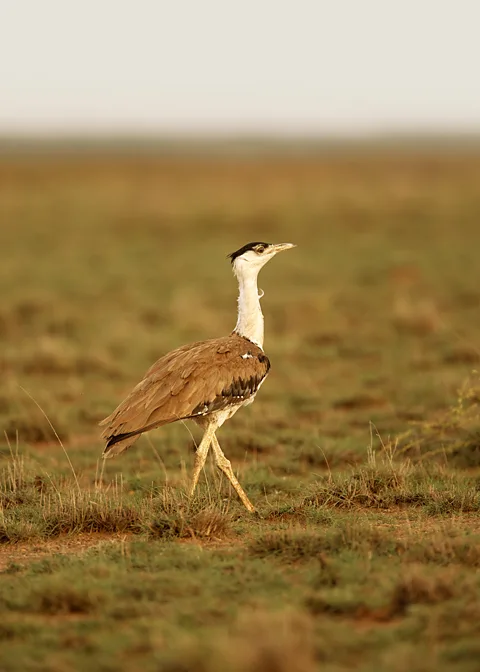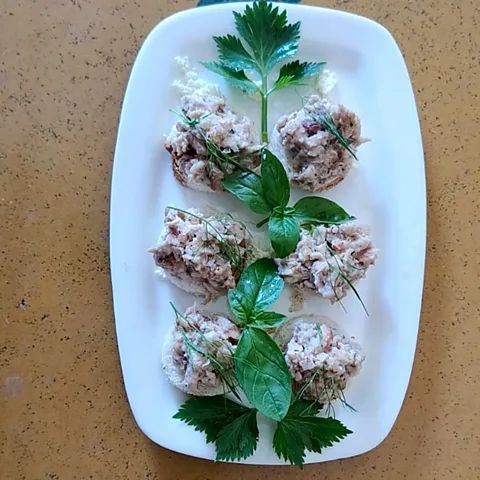Godawan: A whisky made to help a critically endangered bird
 Bajo Rao
Bajo RaoGodawan whisky was created as part of corporate conservation efforts for the endangered Great Indian Bustard. It’s also championed by the king of the Jaisalmer royal family.
Step aside, wine pairings. It is now time for whisky pairings to take centre stage in India. And when that whisky promises to satisfy you while also helping to protect a vanishing bird, all the better.
The bird in question is the Great Indian Bustard – commonly referred to as GIB (and godawan in Hindi) – that has been marked Critically Endangered in the IUCN red list. Once commonly found in the scrublands of the dry desert state of Rajasthan in western India, this bird has been hunted for food and sport to a level of near extinction. As one of the bulkiest flying birds in the world, the GIB can grow up to 1.2m in length and weigh up to 15kg. Known for its long legs and long neck extending from a brownish body, this bird will win no beauty pageants, but was once in contention for being named India's national bird.
But according to recent estimates, there are barely 120 GIB left in India.
The alcoholic namesake, Godawan whisky, was created in early 2023 as part of corporate conservation efforts for the GIB. It is an artisanal single malt distilled in the town of Alwar in Rajasthan using locally grown barley and methods that require minimal water, in a nod to the arid region where it is produced. There is also a gin-like infusion of Indian botanicals that is said to add flavourful touches of raisin, fig, apricot and caramel.
Chaitanya Raj Singh, a social entrepreneur and young scion of the Jaisalmer royal family (he is the 44th titular king), is also a champion for the GIB cause and works with Godawan whisky's parent company, Diageo, to promote conservation efforts. He says the company has been coordinating with the Indian Ministry of the Environment and Wildlife to secure grasslands – the preferred GIB habitat – to allow more space for the birds to breed and hopefully, flourish.
"This conservation initiative is a step in the right direction. And we hope that we will be able to save the bird… the way it happened for the tiger," he said, referring to the Royal Bengal Tiger that has been brought back from the brink of extinction in India by dedicated conservation efforts.
 Godawan Whisky
Godawan WhiskyWith its smooth texture and hint of smoke and spice, the whisky is well-suited to be enjoyed with red meat, much like red wine. Singh likes it with his signature laal maas (literally: "red meat") canapés, his modern twist on the classic mutton curry found across Rajasthan. The dish is said to have originated in royal kitchens, so it finds a good home with Singh. Some sources say that laal maas has its beginnings in game meat such as deer and wild boar, but this is contested by many experts who claim that laal maas has always meant mutton.
"Meat, especially mutton, has been an integral part of the diet of people here in Rajasthan," Singh explained. While the basic dish refers to meat curry made with yoghurt and spices, he adds that "every region, even every household, has a different way of making laal maas". The variation comes both from the kind of spices used and the length of the cooking process – the slower, the better.
It is a thick and rich gravy that makes generous use of onions, garlic, ghee, yoghurt and myriad spices such as cayenne pepper, cardamom pods, cloves and bay leaves to bring out its complex flavours. But no tomatoes please (in what is considered the classic recipe) – the yoghurt works adequately to add a touch of acidity.
The recipe typically calls for copious use of local red chilli powder made from mathania, an indigenous chilli variant grown near Jodhpur, along with hotter chilli varieties – to achieve both the fiery look and taste of this red curry – but Singh likes to tone it down to suit all palates. "The whisky will also go down well when the laal maas canapés taste more mellow," he said.
 Girdhar Malhotra
Girdhar MalhotraServes 4
This rendition of laal maas is a drier version of the curry, served on top of an Indian flatbread like roti or naan, as an appetiser or finger food.
Ingredients
For the laal maas:
250g Greek yoghurt
turmeric powder
500g red meat such as mutton, cut into 2 ½cm (1in) pieces
ghee
10g garlic paste
10g ginger paste
salt
50g chopped onions, chopped
50g tomatoes, chopped
2-3 whole cloves
2-3 cardamom pods
1 bay leaf
10g coriander powder
5g cumin powder
15g red chilli powder
coriander leaves and fried garlic, for serving
For the canapé base:
250g wheat flour
180ml warm water
salt
Method
Step 1
In a bowl, combine the yoghurt and a large pinch of turmeric. Add the meat. Marinate for at least 2 hours.
Step 2
Heat the ghee in a non-stick frying pan, then add the garlic and ginger paste and cook over moderate heat until the garlic turns slightly brown. Add the marinated mutton and sprinkle with salt.
Step 3
Stir in the chopped onions and chopped tomatoes and cook until the onion is lightly golden. Add the cloves, cardamom and bay leaf and cook for 10 minutes, stirring. Stir in the coriander powder, cumin and a pinch of turmeric and season with salt, then stir in the red chilli powder.
Step 4
Add enough water to cover the mutton and bring up to a simmer. Cover and cook for 5-7 minutes, or until the mutton is cooked through. Uncover and cook over low heat, stirring, until a rich sauce forms in the consistency of gravy.
Step 5
To make the canapés base, put the wheat flour in a bowl, add a pinch of salt and add enough water to form a dough. Cover with a wet cloth for 5 minutes to get a fine quality bread.
Step 6
Roll the dough into 2½cm (1in) balls and flatten to form the bases for the canapés. Heat a non-stick frying pan and cook the dough balls until golden and cooked through on both sides, flipping periodically.
Step 7
Place the mutton pieces on the top of the breads, garnish with fried garlic and fresh coriander leaves. Serve hot.
BBC.com's World's Table "smashes the kitchen ceiling" by changing the way the world thinks about food, through the past, present and future.
If you liked this story, sign up for The Essential List newsletter – a handpicked selection of features, videos and can't-miss news delivered to your inbox every Friday.
